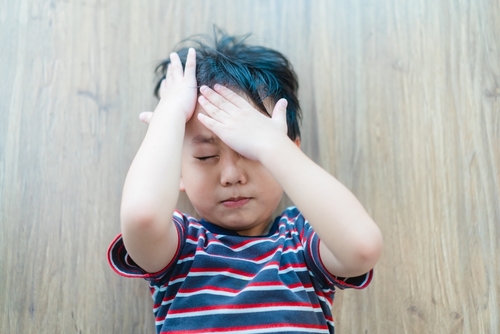
Table of contents
What is epilepsy?
Epilepsy is a brain condition that causes reoccurring seizures. In most cases, seizures are triggered by abnormal electrical signals within the brain. This can be caused by an injury, damage to the brain or can occur naturally, through genetics.
Epilepsy is thought to be the most common neurological condition in the world and although not always associated with the younger population, in the UK, it’s estimated that over 50,000 children are living with epilepsy.
What causes epilepsy in children?
There are a few different factors which could trigger epilepsy in babies and children.
Causes of epilepsy can include:
- Being born prematurely or at a low weight
- A lack of oxygen to the brain at birth (perinatal hypoxia)
- Contracting an infection during the early years of life, such as meningitis
- Genetics – inheriting a condition or disorder that triggers seizures, such as Self-limited (familial) infantile epilepsy (SeLIE)
Where in some cases there will be a clear explanation, the exact reason why epilepsy occurs isn’t always easy to pinpoint. If there is no obvious cause for the seizures, a specialist will look further into your child’s experience and symptoms with the aim of finding out the potential trigger(s).
What are the symptoms of childhood epilepsy?
The most common symptom of epilepsy is seizures. However, these seizures don’t always manifest exactly how you would think and can be particularly difficult to spot in young babies.
Different types of seizures
- Clonic seizures – this type of seizure is most common in babies and involves jerking movements which are usually followed by the body stiffening. The whole seizure typically lasts around 1-2 minutes.
- Tonic seizures – there are two types of tonic seizures, generalised tonic seizures which affect the whole body and focal tonic seizures which affect only part of the body, for example the arms or the legs. In a tonic seizure, the muscles will tense and become stiff. These seizures usually come on suddenly, and the child may lose awareness briefly, with limited knowledge of the seizure taking place.
- Subtle seizures – as the name suggests, the symptoms of this type of seizure can be difficult to identify. They are most common in babies and can include things like a change in breathing pattern or small jerks to different parts of the body.
- Absence seizures – during an absence seizure, children will temporarily blank out. They may look like they are daydreaming or staring into space and likely won’t respond to anything around them until the seizure is over.
- Myoclonic seizures – these seizures are very similar to clonic seizures but are usually more brief, lasting only a couple of seconds. For this reason, they can be hard to identify.
- Focal seizures – focal seizures are different to most other examples as they can affect a child’s behaviour as well as how they feel. They can include involuntary gestures such as lip smacking, twitching or fidgeting as well as pins and needles, being able to smell or taste things that aren’t there and feelings like deja vu or being in a dreamlike state.
Two variations of focal seizures
- Focal aware: where the child will be fully awake and alert during the seizure, with full recollection of what happened.
- Focal impaired awareness: where the child isn’t alert during the seizure and typically won’t remember it happening.
Febrile seizures are another type of seizure that children may experience. These are most common in children under 6 years old and are triggered by a raised temperature, usually as a result of an infection or illness. Although febrile seizures are not epilepsy, children who experience these seizures are more at risk of developing epilepsy later in life.
How is epilepsy diagnosed in young children?
Following initial appointments with your GP, you should be referred to a paediatrician who will seek to find more information about your child’s symptoms.
They may also ask for additional information such as:
- Details of pregnancy and birth of your child.
- If any head injuries have occurred.
- If there is a family history of epilepsy.
There are a few different tests a paediatrician may carry out to determine whether or not your child has epilepsy, or if they suspect a different condition.
These tests can include:
- Blood tests
- Brain scans, such as an MRI or CAT scan
- An EEG (Electroencephalogram)
Epilepsy syndromes
Following tests and examinations, a child may be diagnosed with an epilepsy syndrome. Being diagnosed with a syndrome is almost an extension of an initial epilepsy diagnosis, providing more information about the specific type of epilepsy a child is living with.
Not all children will receive a diagnosis for an epilepsy syndrome; it will depend on the information a specialist has about the child’s symptoms and whether these symptoms come under one of the syndrome categories.
There are a range of different syndromes and they tend to be categorised by the age when children first started experiencing their symptoms.
Epilepsy Action has differentiated epilepsy syndromes into three different categories:
Syndromes which start when children are under 2 years old:
- Dravet syndrome
- Early-infantile developmental and epileptic encephalopathy (EIDEE)
- Gelastic seizures with hypothalamic hamartoma (GS-HH)
- Genetic epilepsy with febrile seizures plus (GEFS+)
- Glucose transporter 1 deficiency syndrome (Glut1DS)
- Infantile epileptic spasms syndrome
- Myoclonic epilepsy in infancy
- Self-limited (familial) infantile epilepsy
- Self-limited (familial) neonatal epilepsy
- Sturge-Weber syndrome
Syndromes which start when children are over 2 years old:
- Childhood absence epilepsy
- Epilepsy with eyelid myoclonia
- Epilepsy with myoclonic absence
- Epilepsy with myoclonic atonic seizures
- Lennox–Gastaut syndrome
- Self-limited epilepsy with autonomic seizures
- Self-limited epilepsy with centrotemporal spikes
Syndromes that can start at any age:
- Epilepsy with generalised tonic-clonic seizures alone
- Juvenile absence epilepsy
- Juvenile myoclonic epilepsy
- Unverricht-Lundborg disease
You can find more information about each of these syndromes on the Epilepsy Action website here.
Can children outgrow epilepsy?
Although it might sound more like a myth than reality, it’s actually not uncommon for children’s seizures to slow down and cease to occur altogether as they get older.
Whether or not they outgrow the condition will usually depend on the type of epilepsy your child has. In most cases, children whose epilepsy has no known cause are more likely to outgrow their seizures.
Are there treatments available?
For a large majority of children diagnosed with epilepsy, the condition can be successfully managed with medication. Anti-epileptic medication can reduce the number of seizures, manage the severity or stop seizure altogether depending on the nature of the epilepsy.
Once your child has received a diagnosis, a doctor or specialist will work with you and your child to find the best medication for them. This could include a single medication or a mixture of two or more.
When prescribing anti-epileptic medication, doctors will always try to provide the lowest dosage possible to limit any potential side effects.
If medication isn’t effective or it isn’t an option for your child for whatever reason, there are some other ways that epilepsy can be managed.
Other methods include:
- A ketogenic diet
- Vagus nerve stimulation (VNS) therapy
- Surgery
Although receiving an epilepsy diagnosis can be daunting, it is completely possible for children to live full and happy lives with the condition. When diagnosed, your doctor should talk to you (and your child if they are old enough) about how to best manage their epilepsy, including anything they should avoid doing to help prevent seizures.
Helping a child with epilepsy to understand their diagnosis can be an additional challenge. Epilepsy Action provides a range of great resources designed for children to help them better understand their condition.


